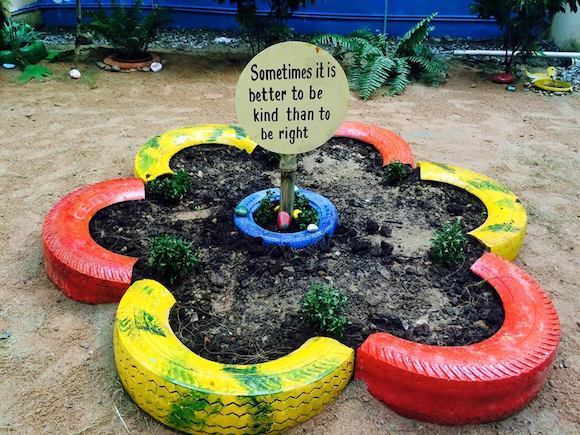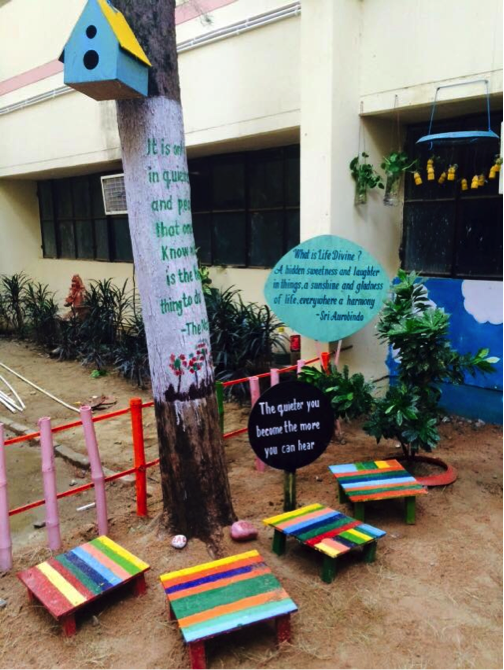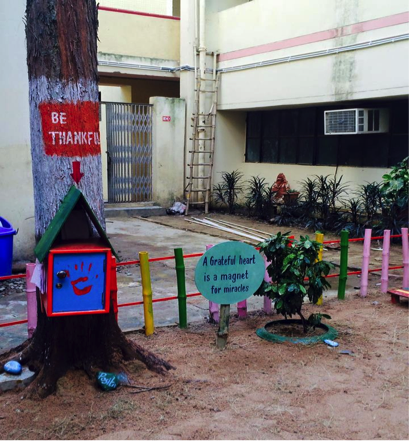What a Greater Good School Looks Like
On a recent trip to India, I was deeply inspired by one school’s efforts to use some of the GGSC’s research-based practices to encourage well-being amongst its students.
Similar to students in the U.S., Indian students often struggle with intense academic pressure, high parental expectations, and, for too many, extreme social and economic barriers. Indeed, suicide rates of 15-29 year olds in India are among the highest in the world.
But a pre-K-12 Seth M. R. Jaipuria School in Lucknow, under the leadership of Anjali Jaipuria, is helping to counter the impact of these challenges by encouraging students to tap into their own and others’ humanity through the practices of gratitude, self-compassion, mindfulness, and more—all of which are transforming the school.
School psychologist Anam Zaidi who led the team that developed these projects recently sent me photos and descriptions of their activities. I thought educators and parents might appreciate seeing some of the exciting work happening in India—and perhaps be inspired to try a few of these activities at their own schools. Enjoy!
A Safe Place Just for Students
Anam invited middle-school students to transform an unused outdoor space into a place where they could take care of their own social and emotional well-being.
“Indian students have a harder time than Western students expressing their emotions,” explained Anam. “So we wanted them to have a space where they could feel safe to do so.”
Students spent seven days happily painting fence posts, rocks, and old tires; creating signs with inspiring quotes; and planting flowers and saplings, often with the help of senior students who willingly took direction from the younger ones. They even enlisted the help and advice from the school’s carpenter and gardener, bridging the sometimes-wide gap between social classes by experiencing the “dignity of labor”.
The result? A “Healing Habitat” just for them.
Within the ‘Healing Habitat’, spaces were created to encourage students to practice some of the Greater Good themes.

The Garden of Kindness
When a student does something kind for another person, he or she plants a sapling in the garden of kindness.
“Now they’re looking for a reason to be kind so they can plant a tree,” said Anam. “It motivates them to be kind, but it also helps them feel good about themselves.”

The Let It Go Pond
Students write on a pebble something that they would like to let go of such as anger or jealousy and then drop it into the pond where it disappears.
“Sometimes adults teach kids that certain emotions are ‘bad’ and should be repressed,” explained Anam. “But the truth is that each emotion has in itself the power to change oneself. The pond is a symbolic way to help students realize that the power to improve lies within.”

The Tree of Silence
The tree of silence provides a place for introspection and meditation, particularly if children have gotten involved in a conflict.
“The tree encourages students to reflect upon their actions by observing a moment of silence,” said Anam. “But I’ve also seen kids just come and sit there.” Teachers, too, are reinforcing the power of silence by opening and closing each class with a mindfulness practice.

The Tree of Self-Forgiveness
Students come to the tree to fill out a paper leaf on which is written, ‘I forgive myself for….’, and then they hang the leaf on the tree.
Anam felt that self-forgiveness was more important to emphasize than forgiveness of others because of the way Indian society views forgiveness. “Sometimes, forgiving someone can give the person doing the forgiving a sense of superiority,” stated Anam. “They think, ‘I’ve forgiven you for something and don’t forget it.’ But if we introduce the concept of learning to forgive yourself first, one might forgive others in a more compassionate way.”
Focusing on self-forgiveness also helps students accept themselves as they are, boosting their self-confidence. Even the senior students hang leaves on the tree. “They quietly walk around,” described Anam, “and put up a leaf when no one is looking. Their leaves often say things like ‘my face’, ‘breaking people’s hearts’, ‘confessing my feelings to someone’, or ‘not talking nicely to my mom.’ The tree has become so popular that I wonder if I should quit my job and just cut out leaves.”
The Gratitude Tree
At the Gratitude Tree, students write on a slip of paper something or someone they’re grateful for and place it in the box. Anam then pulls out the slips of paper and posts them on a bulletin board for all to see (as long as they’re not too personal).
“The tree of gratitude is a gentle reminder to all of us that no matter how busy we are, there is always something we can be thankful for,” said Anam.
Self-Compassion for Kids
In addition to the Healing Habitat, Anam has been implementing other Greater Good practices including self-compassion in classrooms.
“Admitting mistakes is very difficult and very rare for most of us,” explained Anam. “We always try our best to hide our shortcomings because we are governed by this strong belief that being imperfect means being a failure. Practicing self-compassion gives students a safe outlet to acknowledge their authentic selves by addressing those parts of themselves that they don’t feel good about.”
For one month, students in kindergarten through 4th grade practiced a self-hug at the end of each day and remembered that no matter what happened that day, they still had the Divine Spark within which makes them unique beings.
 Self-compassion hugs
Self-compassion hugs
Older students wrote anonymous self-compassion letters and then gave them to Anam (all 4,000 of them!), which, to her surprise, broke the ice between her and the students who were not used to having a counselor with whom they could share their challenges.
Here are a few samples of what they wrote:
I feel bad for being a girl because boys get more freedom than girls. Though gender bias is now less that it used to be, still the rights are not there for girls. If a friend had the same problem, I would say that when we grow up, we would make every man in our upcoming generation have respect for women and give her all her rights.
I feel ashamed that I have a dark complexion and I also feel very bad about my rank in the class. I do not have many friends and I am not good in studies. Everyone makes fun of my fat and rank in class. If someone else had these problems, I would give advice to never feel that you are a loser. Everyone in his or her life is a loser for sometime, but a loser always becomes a winner when he or she has faith and believes in him or herself.
I am ashamed of my height and all my friends taunt me because of my height. But I do not take it seriously because my favorite Cricketer Sachin Tendulkar’s height is small and he has made the most number of runs in cricket history. My advice is to not mind what people say and to listen with one ear and let it go from the other ear.
Impact on Students and Teachers
Anam discovered that giving students the opportunity to share their inner lives with each other in a non-compulsory and safe way has helped to create a more cohesive community. “When students hear what other students are grateful for—especially from those they have never talked to because of social and economic divisions—all of a sudden they realize that they’re more alike than different.”
 And perhaps one of the loveliest outcomes is the effect these practices have had on the teachers. “When students express gratitude for one of their teachers, I often see a change in that teacher,” said Anam. “A stern teacher begins to treat students with more kindness. Or a tired teacher becomes more enthusiastic about her work.”
And perhaps one of the loveliest outcomes is the effect these practices have had on the teachers. “When students express gratitude for one of their teachers, I often see a change in that teacher,” said Anam. “A stern teacher begins to treat students with more kindness. Or a tired teacher becomes more enthusiastic about her work.”
In the end, the work being carried out in Seth M.R. Jaipuria School speaks to the universality of human emotions and values and the need for connection. Providing students with the time and safe space to cultivate their own well-being through gratitude, forgiveness, silence, and other practices that affirm their humanity, Anam has given to Jaipuria students what all children desire, no matter where they’re from—to be seen and valued for who they are by their teachers, their peers, and by their own selves.
This article is printed here with permission. It originally appeared on Greater Good, the online magazine of the Greater Good Science Center (GGSC). Based at UC Berkeley, the GGSC studies the psychology, sociology, and neuroscience of well-being, and teaches skills that foster a thriving, resilient, and compassionate society.
SHARE YOUR REFLECTION
6 Past Reflections


On Apr 11, 2018 Sheridan Rocher wrote:
Wonderful. I'm wondering how I can make my own garden a garden of kindness. We all need frequent reminders of all of these things to soften our hearts.

On Apr 10, 2018 Sidonie Foadey wrote:
Thrilled! Thanks for sharing this beautiful initiative. I just feel like visiting this school on my next trip to India... Really looking forward to it. Namasté!

On Apr 9, 2018 Patrick Watters wrote:
In my grandchildren's public school here in Sacramento, Leonardo da Vinci K-8, we have a similar place of learning and encouragement. 👍🏼❤️

On Apr 9, 2018 Cletus Zuzarte wrote:
Wonderful, just imagine if I had studied in this school, I would have been a different person! Grateful for who I am, but also just want other children too, to get an opportunity like this!




On Apr 17, 2018 Rashmi Kaman Pait wrote:
Great job...Thank you for sharing such a great idea of understanding feelings in different way....really myself as a school counselor I can understand how important it is to express feelings and being accepted by people around us...Anam gr8 work... i m inspired and would like to implement in my school too.👍
Post Your Reply